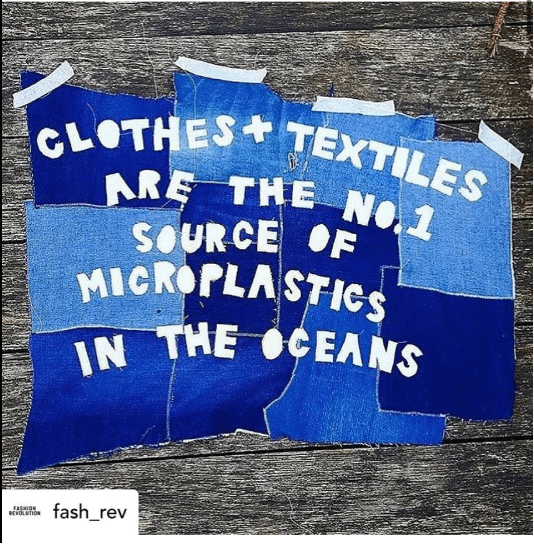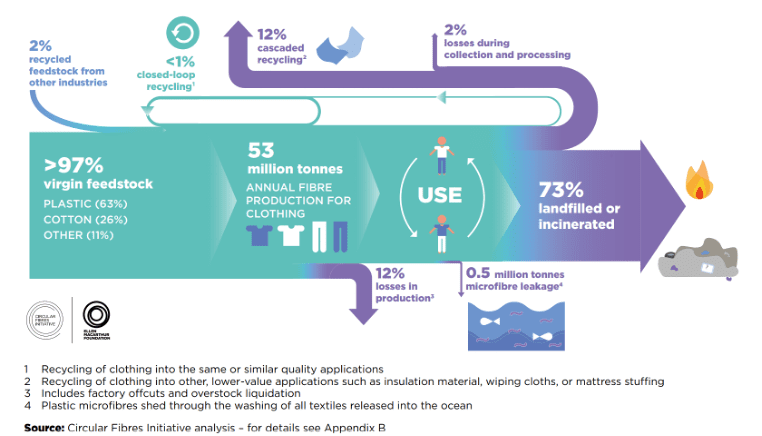Don’t be fooled: Greenwashing in fashion
Growing interest in sustainable fashion has prompted brands from Prada to Primark to communicate their environmental and ethical credentials. Several fashion businesses have launched sustainable sub-brands, among them H&M’s Conscious Collection and Zara’s Join Life brand.
But which businesses are genuinely benefitting the environment, and which are hoping to bamboozle shoppers into thinking they’re greener than they really are? Accusations of greenwashing have been levelled at many fashion brands, whose eco-friendly marketing all-too-often disguises the reality of environmental harms and worker exploitation.
So, how can you tell real green from greenwashed?
What is greenwashing?
Greenwashing refers to the practice of falsely promoting an organization’s environmental efforts. It is a form of corporate disinformation.
The term “greenwashing” was originally coined in 1986 by environmentalist Jay Westerveld. He was struck by the hypocrisy of a hotel that claimed that to encourage guests to reuse towels as part of their efforts to protect the environment. It is true that laundering fewer towels benefits the environment. However, the hotel’s true intent was cost saving, so they created a false impression of ecological stewardship. Paradoxically it’s because greenwashing frequently contains an element of truth that it can be so insidious.
Common forms of greenwashing include selectively sharing information that presents positive environmental attributes of a product, while ignoring significant negatives. One example is paper-based products made from a sustainably harvested forest. This suggests that they are an ecologically positive choice, but in fact greenhouse gas emissions and chlorine used to bleaching paper are both likely to account for greater environmental impacts than forestry. Other forms of greenwashing include making vague claims that are likely to be misunderstood, making unsubstantiated claims, and making irrelevant claims.
Why is greenwashing damaging?
Greenwashing has become a widespread practice: The Competition and Markets Authority (CMA) reported in 2021 that 40% of environmental claims across all sectors were potentially misleading.
This is problematic for two reasons. First, it disadvantages companies that offer genuinely environmentally positive products, since customers can’t easily tell the genuine article from the pretenders. Second, greenwashing has eroded trust and has become a barrier to consumers making sustainable choices. A 2020 study by Ipsos shows that globally half of consumers find sustainability claims confusing, or disbelieve them (Table 1). This is hugely damaging.

Table 1 –Views on labelling of fair trade, sustainable and organic products. Source – ‘The Sustainability Imperative’. Ipsos, 2020
How does greenwashing show up in fashion?
Few industries are more vulnerable to greenwashing than apparel. The fashion industry has grown exponentially over recent years, generating gigantic environmental and social footprints. Yet highly complex supply chains and off-shore production mean that the ecological consequences of our wardrobes can be out-of-sight and out-of-mind. So many and varied are the environmental aspects of fashion that companies can easily promote one ‘green’ aspect of their product, while staying silent about the negatives. Meanwhile, increased interest among consumers in environmentalism has tempted more clothing brands into misleading messaging, says Josephine Palumbo of The International Consumer Protection and Enforcement Network (ICPEN).
The CMA’s 2021 report sets out six principles that companies should follow to avoid greenwashing. Here’s how fashion companies may be breaching four of them:
(1) Claims must be truthful and accurate
The requirement that claims be truthful and accurate should go without saying – but the CMA has noted many instances where this criterion is not met. They add, “Terms like ‘green’, ‘sustainable’ or ‘eco-friendly,’ especially if used without explanation, are likely to be seen as suggesting that a product, process, brand or business as a whole has a positive environmental impact, or at least no adverse impact. Unless a business can prove that, it risks falling short of its legal obligations.”
In the fashion world, sustainable clothing collections tend carry reassuring labels such as ‘conscious’ or ‘responsible’. According to the CMA, using a general term like this might encourage shoppers to believe that these clothing ranges have no negative environmental effects. That’s rarely the case. Typically, a ‘conscious’ or ‘responsible’ range consists of clothes made partly from sustainable or recycled fabrics, typically 50% recycled. That’s certainly an improvement on 0% recycled, but the 50% that’s non-recycled likely has a substantial carbon footprint, and may have been treated using toxic chemical dyes. Additionally, whether recycled or not, materials such as polyester shed microplastics when laundered that found their way into oceans, according to Fashion Revolution. So, overall, these garments labelled ‘conscious’ or ‘responsible’ frequently cause significant detrimental environmental effects.

(2) Claims should be clear and unambiguous
According to the CMA, claims about future goals should be based on specific, measurable and verifiable commitments. All too often, fast fashion brands have published statements of intent that do not meet these criteria. For example, ‘by 2030 all of our garments will be made from more sustainable fabrics’. That sounds good, but what does ‘more sustainable’ mean? Does it imply that all materials will be designed not to shed microfibres, or not? Is the company committing to certification from independent third parties such as GOTS, or will these improvements be self-certified? There are far too many fashion brands with vague, non-measurable and unverified sustainability plans. Instead, fashion companies should be setting tangible, science-based targets to reduce their carbon footprints and their usage of both water and polluting chemicals.
(3) Claims should not omit or hide important information
‘What claims don’t say can also influence the decisions consumers make’, observe the CMA. Many commentators have pointed out that fashion brands are highly selective about which information they share. Primark’s corporate responsibility page states that, ‘Recycling is an important way that all of us can better look after the planet and reduce the amount of waste that ends up in landfill’. This is true. However, Primark’s recycling efforts consist of using paper bags instead of plastic, re-using hangers and donating unsold stock to charities. (Strictly speaking, this not recycling since the clothes are unworn when donated.) Primark makes no reference to the fact that the vast majority of its clothing will recycled at the end of its life because the synthetic fabrics they use end up in landfill. In fact, only about 1% of all clothes are recycled back into new clothes or products of a similar quality– see Figure 2.

Figure 2 Global Material Flows (2015). Source: A new Textile Economy, The Ellen McArthur Foundation, 2017
(4) In making the claim you should consider the full life cycle of the product
The CMA calls on manufacturers to consider all aspects of a product’s or service’s environmental impact over its life cycle, including its supply chain, how and where it is manufactured, the disposal of a product, and any waste or by-products.
Many ‘sustainable’ clothes are manufactured in countries such as China and therefore travel very long distances to their eventual point-of-sale, sometimes by air, generating carbon emissions on their way.
As already noted, the end-of-life disposal of clothing is problematic, with the majority of clothing finding its way to landfill. This problem is compounded because few items of clothing are biodegradable – that includes clothes from fast fashion brand’s conscious and responsible edits. The sheer amount of clothing that ends up incinerated or in landfill is a huge concern. Many activists believe that the fast fashion business model which is built on consumers shopping frequently and quickly discarding their clothes can never be sustainable, regardless of improvements to how clothes are made: the focus should be on reducing how much we buy and slowing production rates rather than switching to better fibres, says Venetia La Manna.
How can you avoid greenwashing?
Currently, greenwashing is difficult to avoid because it is so widespread. Additionally, the issues of sustainability in fashion are complex: There’s a range of factors to consider, from a garment’s GHG emissions and water footprint to what’s likely to happen to it when you’ve finished wearing it: is it likely to be re-sellable or recyclable? Assessing such a breadth of environmental impacts is no easy task for shoppers. This is a big part of the problem: greenwashing has been allowed to flourish because making environmentally sound choices relies on consumers navigating a complex decision-making process. It is unrealistic to expect that more than a small minority of unusually well-informed consumers will do so.
One obstacle for those wanting to avoid greenwashing is a low level of legal protection – at present, consumer protection law does not specify what information companies must give regarding the environmental impacts of their products. More stringent environmental laws would certainly be an important step forward, both for the fashion industry and other sectors. In an ideal world, all companies would have to display information about relevant environmental impacts at the point of purchase – much like food labels’ traffic lights indicating levels of fat, salt and sugar.
Unless and until legislation is tightened up, looking for reliable independent certifications such as GOTS organic certification, B Corp endorsement or FairTrade logos can help sidestep greenwashing. So can checking resources such as Good on You, whose website and app offers detailed and up-to-date assessment of brands’ environmental and social credentials.
It’s also so important to take action by writing to political representatives calling for more stringent governance: most academics who have investigated the greenwashing phenomenon agree that audits, verification, and validation of environmental performance are all perquisites for eliminating greenwashing. This is unlikely to happen without stricter governance in place.

